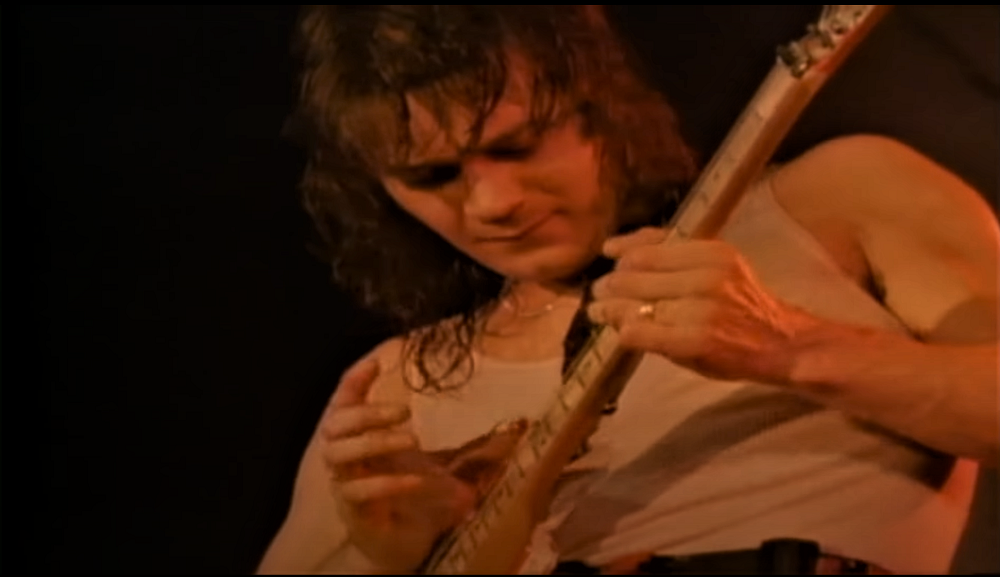The musician lived for his music and six-string

Eddie Van Halen.
If there’s one recording that sums up Eddie Van Halen’s guitar wizardry, it’s his performance at New Haven, Connecticut, on August 27th, 1986. For nearly 13 minutes, the master is alone on stage, using his ‘Frankenstrat’ guitar to demonstrate every trick in the book. This custom-made instrument blended the sound of the Gibson with the physical attributes of a Fender Stratocaster, with Eddie popularising a technique known as ‘two-hand tapping.’
A YouTube video of that historic performance has been doing the rounds, ever since the rock world was shattered by the news that their 65-year-old guitar hero had died on October 6th, after a long battle with cancer. Instantly, minds went back to the year 1984, when his group Van Halen had a mega-hit in the song “Jump.” Known for his limitless energy on stage, Eddie had a trademark way of jumping while playing. And it wasn’t only the rock fans that he attracted – his uncredited cameo on Michael Jackson’s 1982 hit “Beat It” had enchanted the pop world too.
Forever an interviewer’s delight, Eddie had once described the “Eruption” guitaring as ‘Godzilla waking up.’ In another instance, he had told Rolling Stone in 1980, “I don’t know a thing about scales or music theory. I don’t want to be seen as the fastest guitar in town, ready and willing to gun down the competition. All I know is that rock ‘n’ roll’ guitar, like blues guitar, should be melody, speed and taste, but more important, it should have emotion. I just want my guitar playing to make people feel something: happy, sad, even horny.” Clearly, that set him apart, and he was to the 1980s what Eric Clapton and Led Zeppelin’s Jimmy Page were a decade earlier.
Edward Lodewijk Van Halen and his elder brother, Alex Van Halen, were born in Nijmegen, the Netherlands, but the family eventually shifted to Pasadena, California. Interestingly, as youngsters, Eddie played the drums and Alex learned the guitar, but somewhere down the line, they traded instruments. The group Van Halen was formed in 1974, with vocalist David Lee Roth and bassist Michael Anthony joining. Playing on the local club circuit, they were often dismissed as Led Zeppelin or Deep Purple wannabes, though Eddie was himself inspired by the Kinks too, eventually covering three of their songs.
Slowly, the group tightened its act, and by the time it released its self-titled debut in 1978, the fans had increased. Tracks like the very short rendition of “Eruption,” “Running With The Devil” and a version of the Kinks song “You Really Got Me” added to their popularity. The next four albums expanded their audience, and the success of Michael Jackson’s “Beat It” added a new dimension to Eddie’s career.
By the time 1984 was released, hard rock and heavy metal were at their peak, with punk and disco on a decline. Bands like Iron Maiden, Judas Priest, Quiet Riot, Def Leppard, and Scorpions attracted the younger lot. Van Halen was part of that overall sound, and the songs “Jump,” “Panama,” “Hot For Teacher” and “I’ll Wait” were hugely successful. On “Jump” and “I’ll Wait,” the group also experimented, using keyboards prominently. Their style was described by MTV VJs as ‘platinum flash metal.’
Like many 1980s rock groups, Van Halen had its share of tussles and line-up changes. Following ego clashes, vocalist Roth left. The replacement was Sammy Hagar, formerly of the Californian hard rock band Montrose. Looking for a new direction, Van Halen roped in Mick Jones of Foreigner to handle production of their next album 5150, named after Eddie’s home studio.
Hagar left recording four albums in a decade, and Gary Cherone of Extreme recorded Van Halen III in 1998, the ‘III’ referring to the number of times the line-up changed. Later developments included a brief reunion with Hagar, and the arrival of Eddie’s son Wolfgang (named after classical composer Mozart) on the 2012 album A Different Kind of Truth.
While Eddie had been battling various health issues – hip injury, alcoholism, intestine infection, cancer – for the past two decades, he continued to influence various later-day musicians. Even in their prime, Van Halen’s descendants included Motley Crue, Bon Jovi, Extreme and Poison.
Following the news of his death, the tributes started flowing in. On Instagram, blues-rock guitarist Kenny Wayne Shepherd described him as the “Jimi Hendrix of my generation.” Guitarist Steve Vai simply wrote, “Thank You King Edward.” Jazz fusion guitarist Al Di Meola said, “I always regarded Eddie as someone who completely revolutionalized a way of playing in a new style that inspired a generation of guitar players.” Singer-guitarist John Mayer wrote, “Looking up to him as a young kid was one of the driving forces in my needing to pick up a guitar.”
Clearly, Eddie Van Halen lived for his music and his guitar. As he once said, “If you want to be a rock star or just be famous, then run down the street naked, you’ll make the news or something. But if you want music to be your livelihood, then play, play, play and play! And eventually, you’ll get what you want to be.” Those golden words sum up everything he stood for.
As its sound gets more intense, ‘Smoke Point’ references the heat and fiery intensity that…
The Blackpink singer released her first new music of 2025 ahead of her upcoming solo…
The Afrobeats star teased the track in November, and some fans have been clamoring for…
A source at Republic Records confirms the June 6 release date to Rolling Stone
In their first interview since canceling their North American tour and splitting with high-powered manager…
Chennai’s seasoned rock trio start a new chapter in their conceptual universe